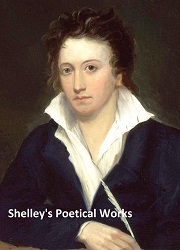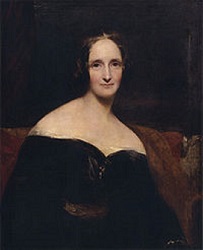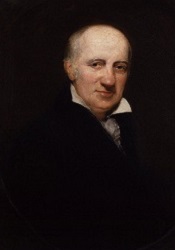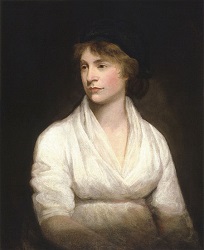BOOKS BY THE SHELLEY CLAN
Percy Bysshe Shelley, his wife Mary Shelley, her father William Godwin, and her mother Mary Wollstonecraft

Percy Bysshe Shelley
According to Wikipedia: "Percy Bysshe Shelley (4 August 1792 – 8 July 1822) was one of the major English Romantic poets and is critically regarded as among the finest lyric poets in the English language. A radical in his poetry and his political and social views, fame eluded him during his lifetime, but recognition grew steadily following his death. Shelley was a key member of a close circle of visionary poets and writers that included Lord Byron; Leigh Hunt; Thomas Love Peacock; and his own second wife, Mary Shelley, the author of Frankenstein. Shelley is perhaps best known for such classic poems as Ozymandias, Ode to the West Wind, To a Skylark, Music, When Soft Voices Die, The Cloud and The Masque of Anarchy. His other major works include long, visionary poems such as Queen Mab (later reworked as The Daemon of the World), Alastor, The Revolt of Islam, Adonaïs, the unfinished work The Triumph of Life; and the visionary verse dramas The Cenci (1819) and Prometheus Unbound (1820). Shelley's early profession of atheism (in the tract "The Necessity of Atheism") led to his expulsion from Oxford and branded him a radical agitator and thinker, setting an early pattern of marginalisation and ostracism from the intellectual and political circles of his time. His close circle of admirers, however, included some progressive thinkers of the day, including his future father-in-law, the philosopher William Godwin. Though Shelley's poetry and prose output remained steady throughout his life, most publishers and journals declined to publish his work for fear of being arrested themselves for blasphemy or sedition. Shelley did not live to see success and influence, although these reach down to the present day not only in literature, but in major movements in social and political thought."
The Complete Poetical Works of Percy Bysshe Shelley
The 3-volume Oxford edition, edited by Thomas Hutchinson, and first published in 1904. According to Wikipedia: "Percy Bysshe Shelley (August 4, 1792 – July 8, 1822) was one of the major English Romantic poets and is widely considered to be among the finest lyric poets of the English language. He is perhaps most famous for such anthology pieces as Ozymandias, Ode to the West Wind, To a Skylark, and The Masque of Anarchy. However, his major works were long visionary poems including Alastor, Adonais, The Revolt of Islam, Prometheus Unbound and the unfinished The Triumph of Life."
99 cents at Kobo
99 cents at Nook (Barnes & Noble)
Defense of Poetry and Other Essays by Percy Bysshe Shelley
According to Wikipedia: "A Defence of Poetry is an essay by the English poet Percy Bysshe Shelley, written in 1821 and first published posthumously in 1840 in Essays, Letters from Abroad, Translations and Fragments (1840) [1839]. It contains Shelley's famous claim that "poets are the unacknowledged legislators of the world".
99 cents at Kobo
99 cents at Nook (Barnes & Noble)
According to Wikipedia: "Mary Shelley (née Mary Wollstonecraft Godwin; 30 August 1797 – 1 February 1851) was an English novelist, short story writer, dramatist, essayist, biographer, and travel writer, best known for her Gothic novel Frankenstein: or, The Modern Prometheus (1818). She also edited and promoted the works of her husband, the Romantic poet and philosopher Percy Bysshe Shelley. Her father was the political philosopher William Godwin, and her mother was the philosopher and feminist Mary Wollstonecraft. Mary Godwin's mother died when she was eleven days old; afterwards, she and her older half-sister, Fanny Imlay, were raised by her father. When Mary was four, Godwin married his neighbour, Mary Jane Clairmont. Godwin provided his daughter with a rich, if informal, education, encouraging her to adhere to his liberal political theories. In 1814, Mary Godwin began a romantic relationship with one of her father’s political followers, the married Percy Bysshe Shelley. Together with Mary's stepsister, Claire Clairmont, they left for France and travelled through Europe; upon their return to England, Mary was pregnant with Percy's child. Over the next two years, she and Percy faced ostracism, constant debt, and the death of their prematurely born daughter. They married in late 1816 after the suicide of Percy Shelley's first wife, Harriet. In 1816, the couple famously spent a summer with Lord Byron, John William Polidori, and Claire Clairmont near Geneva, Switzerland, where Mary conceived the idea for her novel Frankenstein. The Shelleys left Britain in 1818 for Italy, where their second and third children died before Mary Shelley gave birth to her last and only surviving child, Percy Florence. In 1822, her husband drowned when his sailing boat sank during a storm in the Bay of La Spezia. A year later, Mary Shelley returned to England and from then on devoted herself to the upbringing of her son and a career as a professional author."
Frankenstein or the New Prometheus by Mary Shelley
According to Wikipedia: "Frankenstein; or, The Modern Prometheus is a novel written by Mary Shelley about a creature produced by an unorthodox scientific experiment. Shelley started writing the story when she was nineteen, and the novel was published when she was twenty-one. The first edition was published anonymously in London in 1818. Shelley's name appears on the second edition, published in France in 1823. Shelley had travelled in the region of Geneva, where much of the story takes place, and the topics of galvanism and other similar occult ideas were themes of conversation among her companions, particularly her future husband, Percy Shelley. The storyline emerged from a dream. Mary, Percy, Lord Byron, and John Polidori decided to have a competition to see who could write the best horror story. After thinking for weeks about what her possible storyline could be, Shelley dreamt about a scientist who created life and was horrified by what he had made. She then wrote Frankenstein."
99 cents at Kobo
99 cents at Nook (Barnes & Noble)
The Last Man, all three volumes, by Mary Shelley
According to Wikipedia: "The Last Man is an apocalyptic science fiction novel by Mary Shelley, which was first published in 1826. The book tells of a future world that has been ravaged by a plague. The novel was harshly reviewed at the time, and was virtually unknown until a scholarly revival beginning in the 1960s. It is notable in part for its semi-biographical portraits of Romantic figures in Shelley's circle, particularly Shelley's late husband Percy Bysshe Shelley and Lord Byron."
99 cents at Kobo
99 cents at Nook (Barnes & Noble)
According to Wikipedia: "William Godwin (3 March 1756 – 7 April 1836) was an Englishpolitical philosopher and novelist. He is considered one of the first exponents of utilitarianism, and the first modern proponent of anarchism. Godwin is most famous for two books that he published within the space of a year: An Enquiry Concerning Political Justice, an attack on political institutions, and Things as They Are; or, The Adventures of Caleb Williams, which attacks aristocratic privilege, but also is the first mystery novel. Based on the success of both, Godwin featured prominently in the radical circles of London in the 1790s. In the ensuing conservative reaction to British radicalism, Godwin was attacked, in part because of his marriage to the pioneering feminist writer Mary Wollstonecraft in 1797 and his candid biography of her after her death; their daughter, Mary Godwin (later Mary Shelley) would go on to write Frankenstein and marry the poet Percy Bysshe Shelley. Godwin wrote prolifically in the genres of novels, history and demography throughout his lifetime. With his second wife, Mary Jane Clairmont, he wrote children's primers on Biblical and classical history, which he published along with such works as Charles and Mary Lamb's Tales from Shakespeare. Using the pseudonym Edward Baldwin, he wrote a variety of books for children, including a version of Jack and the Beanstalk. He also has had considerable influence on British literature and literary culture. journalist,
Caleb Williams, by William Godwin
According to Wikipedia: "Things as They Are; or The Adventures of Caleb Williams ... (1794) by William Godwin is a three-volume novel written as a call to end the abuse of power by what Godwin saw as a tyrannical government. Intended as a popularization of the ideas presented in his 1793 treatise Political Justice Godwin uses Caleb Williams to show how legal and other institutions can and do destroy individuals, even when the people the justice system touches are innocent of any crime. This reality, in Godwin's mind was therefore a description of "things as they are." The original manuscript included a preface that was removed from publication, because its content alarmed booksellers of the time."
99 cents at Kobo
99 cents at Nook (Barnes & Noble)
Thoughts on Man, His Nature, Productions and Discoveries by William Godwin
23 essays including: Body and Mind, Distribution of Talents, Intellectual Abortion, Durability of Human Achievements, Rebelliousness of Man, Human Innocence, Duration of Human Life, Human Vegetation, Leisure, Imitation and Invention, Self-Love and Benevolence, Liberty fo Human Actions, Blief, Youth and Age, Love and Friendship, Frankness and Reserve, Ballot, Diffidence, Self-Complacency, Phrenology, Astronomy, The Material Universe, and Human Virtue.
99 cents at Kobo
99 cents at Nook (Barnes & Noble)
Italian Letters or The History of the Count de St. Julian, both volumes, by William Godwin,
99 cents at Kobo
99 cents at Nook (Barnes & Noble)
According to Wikipedia: "Mary Wollstonecraft (27 April 1759 – 10 September 1797) was an eighteenth-century British writer, philosopher, and advocate of women's rights. During her brief career, she wrote novels, treatises, a travel narrative, a history of the French Revolution, a conduct book, and a children's book. Wollstonecraft is best known for A Vindication of the Rights of Woman (1792), in which she argues that women are not naturally inferior to men, but appear to be only because they lack education. She suggests that both men and women should be treated as rational beings and imagines a social order founded on reason. Until the late 20th century, Wollstonecraft's life, which encompassed several unconventional personal relationships, received more attention than her writing. After two ill-fated affairs, with Henry Fuseli and Gilbert Imlay (by whom she had a daughter, Fanny Imlay), Wollstonecraft married the philosopher William Godwin, one of the forefathers of the anarchist movement. Wollstonecraft died at the age of thirty-eight, ten days after giving birth to her second daughter, leaving behind several unfinished manuscripts. Her daughter Mary Wollstonecraft Godwin, later Mary Shelley, the author of Frankenstein, would become an accomplished writer herself. After Wollstonecraft's death, her widower published a Memoir (1798) of her life, revealing her unorthodox lifestyle, which inadvertently destroyed her reputation for almost a century. However, with the emergence of the feminist movement at the turn of the twentieth century, Wollstonecraft's advocacy of women's equality and critiques of conventional femininity became increasingly important. Today Wollstonecraft is regarded as one of the founding feminist philosophers, and feminists often cite both her life and work as important influences."
A Vindication of the Rights of Women, With Strictures on Political and Moral Subjects by Mary Wollstonecraft
Seminal work on the rights of woman. According to Wikipedia: "A Vindication of the Rights of Woman: with Strictures on Political and Moral Subjects (1792), written by the 18th-century British feminist Mary Wollstonecraft, is one of the earliest works of feminist philosophy. In it, Wollstonecraft responds to those educational and political theorists of the 18th century who did not believe women should have an education. She argues that women ought to have an education commensurate with their position in society, claiming that women are essential to the nation because they educate its children and because they could be "companions" to their husbands, rather than mere wives. Instead of viewing women as ornaments to society or property to be traded in marriage, Wollstonecraft maintains that they are human beings deserving of the same fundamental rights as men. Wollstonecraft was prompted to write the Rights of Woman after reading Charles Maurice de Talleyrand-Périgord's 1791 report to the French National Assembly, which stated that women should only receive a domestic education; she used her commentary on this specific event to launch a broad attack against sexual double standards and to indict men for encouraging women to indulge in excessive emotion. Wollstonecraft wrote the Rights of Woman hurriedly in order to respond directly to ongoing events; she intended to write a more thoughtful second volume but died before completing it."
99 cents at Kobo
99 cents at Nook (Barnes & Noble)
Memoirs of the Author of "A Vindication of Women" by William Godwin
According to Wikipedia: "In January 1798 Godwin published his Memoirs of the Author of A Vindication of the Rights of Woman. Although Godwin felt that he was portraying his wife with love, compassion, and sincerity, many readers were shocked that he would reveal Wollstonecraft's illegitimate children, love affairs, and suicide attempts. The Romantic poet Robert Southey accused him of "the want of all feeling in stripping his dead wife naked" and vicious satires such as The Unsex'd Females were published. Godwin's Memoirs portrays Wollstonecraft as a woman deeply invested in feeling who was balanced by his reason and as more of a religious sceptic than her own writings suggest."
99 cents at Kobo
99 cents at Nook (Barnes & Noble)
Letters on Sweden, Norway, and Denmark by Mary Wollstonecraft
99 cents at Kobo
Maria or the Wrongs of Women by Mary Wollstonecraft
According to Wikipedia: "Maria: or, The Wrongs of Woman is the 18th century British feminist Mary Wollstonecraft's unfinished novelistic sequel to her revolutionary political treatise A Vindication of the Rights of Woman (1792). The Wrongs of Woman was published posthumously in 1798 by her husband, William Godwin, and is often considered her most radical feminist work. Wollstonecraft's philosophical and gothicpatriarchal institution of marriage in eighteenth-century Britain and the legal system that protected it. However, the heroine's inability to relinquish her romantic fantasies also reveals women's collusion in their oppression through false and damaging sentimentalism. The novel pioneered the celebration of female sexuality and cross-class identification between women. Such themes, coupled with the publication of Godwin's scandalous Memoirs of Wollstonecraft's life, made the novel unpopular at the time it was published.Twentieth-century feminist critics embraced the work, integrating it into the history of the novel and feminist discourse. It is most often viewed as a fictionalized popularization of the Rights of Woman, as an extension of Wollstonecraft's feminist arguments in Rights of Woman, and as autobiographical." novel revolves around the story of a woman imprisoned in an insane asylum by her husband. It focuses on the societal rather than the individual "wrongs of woman" and criticizes what Wollstonecraft viewed as autobiographical."
99 cents at Kobo
99 cents at Nook (Barnes & Noble)
Mary, a Fiction by Mary Wollstonecraft
According to Wikipedia: "Mary: A Fiction is the only complete novel by the 18th-century British feminist Mary Wollstonecraft. It tells the tragic story of a heroine's successive "romantic friendships" with a woman and a man. Composed while Wollstonecraft was a governess in Ireland, the novel was published in 1788 shortly after her summary dismissal and her momentous decision to embark on a writing career, a precarious and disreputable profession for women in 18th-century Britain.Inspired by Jean-Jacques Rousseau's idea that geniuses are self-taughtgenius (a word which at the end of the 18th century was only beginning to take on its modern meaning of exceptional or brilliant), Wollstonecraft describes Mary as independent and capable of defining femininity and marriage for herself. It is Mary's "strong, original opinions" and her resistance to "conventional wisdom" that mark her as a genius. Making her heroine a genius allowed Wollstonecraft to criticize marriage as well: geniuses were "enchained" rather than enriched by marriage. Through this heroine Wollstonecraft also critiques 18th-century sensibilityMary rewrites the traditional romance plot through its reimagination of gender relations and female sexuality. Yet, because Wollstonecraft employs the genre of sentimentalism to critique sentimentalism itself, her "fiction", as she labels it, sometimes reflects the same flaws of sentimentalism that she is attempting to expose.Wollstonecraft later repudiated Mary, writing that it was laughable. However, scholars have argued that, despite its faults, the novel's representation of an energetic, unconventional, opinionated, rational, female genius (the first of its kind in English literature) within a new kind of romance is an important development in the history of the novel because it helped shape an emerging feminist discourse."
99 cents at Kobo
99 cents at Nook (Barnes & Noble)
seltzer@seltzerbooks.com privacy statement


